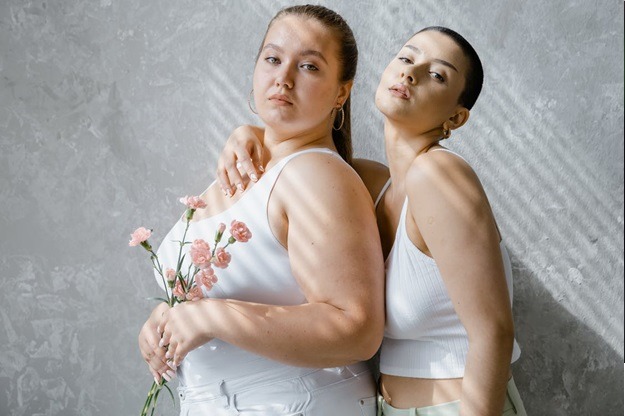The concept of inclusiveness and diversity seemed unrealistic in the fashion industry for a long time. However, the world is changing, and thus, fashion is evolving. Size inclusivity is just one of the many positive changes we can see becoming a part of this industry. This particular market is still largely exploitable and could use more digitization.
Fortunately, the recent advancements in global technology have given rise to virtual-only and e-commerce trends. Such shifts have heavily impacted the fashion businesses too. There has been a significant rise in the numbers of online consumers for many known and lesser-known clothing stores. It has, hence, become equally a responsibility and an opportunity for fashion brands to broaden their market base. They are targeting a wider audience now by becoming more inclusive and making their marketing tactics all-encompassing.
There used to be a time when the plus-size market was not as glamorous as online stores have made it today; instead, it was only a part of the corner in a brick-and-mortar store. It was not only challenging to find plus-size clothing but even more challenging to find trendy fashion well-suited for plus-sized people. It was always the same, bland-colored, loose-cut dresses to disguise their actual body shape, and frankly, it became embarrassing. Because even if size ten models ruled the fashion shows, it was size 14 to 18 which consumers purchased the most.
So, as we progress forward, it is high time that fashion becomes more inclusive. Let’s have a look at how e-commerce and the virtual-only world contribute to that:
1. Use of Augmented Reality
Suppose a customer is looking for plus-size maxi dresses, but they want the design to be similar to what they saw on a slimmer model. Should the company bring in different models to wear the same designed dress? That would be too redundant! As established, technological developments play a significant role in making the online fashion industry inclusive today.
Augmented Reality (AR) is an essential tool companies use to play around with the same clothing on women of different sizes. This way, online buyers can see how the dress would look on someone with their body shape, which helps them make a more informed decision.
This also helps fashion stores make fashion more inclusive and give their customers a variety of choices, increasing customer satisfaction. Another excellent way to use this tool is by developing an AR filter! It allows customers to stand in front of the camera and check how their selected clothing would look on them, saving time and effort.
2. Availability of Wider Size Range
Virtual-only stores are more efficient in terms of providing a more comprehensive size range to their customers because everything is accessible through single-click. Compared to this, brick-and-mortar stores can’t find mannequins of all sizes and put the same designs on them to show their walk-in buyers. But online stores have the affluence to present the same design on different sizes – plus-sized, petite, short, or tall models.
It allows everyone to be themselves and openly become a part of size-inclusive evolution. It has also helped businesses to target a wider audience because they can personalize the experience for everyone on their online stores through websites or applications.
Many brands like Nasty Gal and TopShop made an honest mistake of extending their sizing option to size 18, only and it was not taken well by the audience. The average American women wear sizes 16 to 18, making it evident that sizes greater and smaller should also be a part of the size range. While traditional stores made it unsubtle by cornering the ‘plus-sized’ options, virtual stores end this discrimination by providing everything in one place.
3. More Inclusive Marketing
Virtual-only fashion is also conducive to making the marketing techniques more inclusive. Online forums make it possible to represent and include marginalized people of the community. On many brands’ websites, we can see people of all colors and sizes wearing similar designs as any other fair, slim and tall model. Virtual-only businesses know that they target a broad, often global, market that requires them to include everyone who might visit their websites. They also have different pricing options on their websites so that consumers from different communities can freely browse through their options.
Additionally, some e-commerce stores often have separate tabs for their demographically neglected market, such as transgender individuals, who can swipe through options custom-designed for their comfort without being judged.
4. A Changed Narrative
There is a lot of hope for the future of inclusive fashion as this prospect becomes brighter. However, it is essential to consider that designing and marketing clothes for all sizes is insufficient. Virtual-only businesses are taking a progressive step towards wholly including women of all sizes, shapes, and colors in the fashion industry to change the narrative completely. Unlike in the past, now the fashion for plus-sized women is not limited to black, white, or dull colors only. Instead, models with broad chests, thick thighs, and apple figures are donning on bright and neon-colored dresses. They are no longer portrayed as someone afraid to highlight the curves of their body and someone who should only wear loose-fitting clothes. It is a representation on a whole new level, and it gives customers a choice to be as glamorous as they want by choosing what to wear for themselves. Just like this, ecommerce stores are not just producing clothes in larger sizes but also focusing on providing the same quality of clothes in the same variety of functionality, comfort, and designs available for all customers.
5. A Noticeable Domino Affect
Inclusive fashion, which many virtual-only stores have brought forward, is causing an evolution of style worldwide.
Big brands focus on producing collections that they do not make for any specific size but for people of any size. Brands realize the exploitable market they have neglected for a long time, but this transition will be challenging. Today’s shoppers belong to the generations of Millennials and Gen-Z, and they want to purchase from brands that they can connect to on a personal level. Hence, we see a noticeable domino effect of inclusive fashion as producers are making their clothing lines more diverse, on-by-one. Walmart, which has offered plus-sized clothing for many years, has extended its sizes to XXXL, and major brands like Calvin Klein, Zalando, H&M, and Target have followed through. Additionally, Rihanna’s brand Savage X Fenty is tapping a long-neglected market by introducing lingerie in the plus-sized category, both trendy and glamorous. It has paved a path for many known brands to follow suit.
Conclusion
In conclusion, virtual-only and ecommerce world has significantly contributed towards making fashion inclusive for people of all sizes, shapes, colors despite their racial and ethnic differences. They do it by giving people an option to browse through similar choices—usually only reserved for white and skinny bodies—allowing them to virtually try on new dresses in shape, color and quality.

